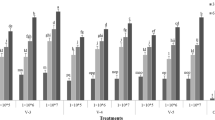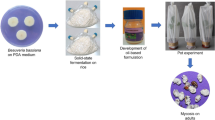Abstract
Western cherry fruit fly, Rhagoletis indifferens Curran (Diptera: Tephritidae), is a pest of cherries (Prunus spp.) in western North America that potentially could be managed using the fungus Beauveria bassiana (Balsamo-Crivelli) Vuillemin (Hypocreales: Cordycipitaceae). Here, the product CX-10282 containing 11.3% B. bassiana strain GHA was evaluated as a potential control agent for adult R. indifferens by determining whether it can cause 100% fly mortality in the laboratory. Low or high label rates of 5.4 × 107 or 1.7 × 108 conidia/ml in five different modes of application and application volumes were tested. When one 1-μl drop of CX-10282 containing 1.6 × 105 conidia was applied onto a single female fly, 100% mortality was reached by 4 or 7 d. When CX-10282 was sprayed into a container with flies to produce 2.2 × 105 to 6.9 × 105 conidia/cm2 and flies left in containers, 76.2–99.5% mortality was reached by 15–21 d. When sprayed flies were moved into clean containers, 74.8% mortality was reached by 25 d. When a 9-cm diam filter paper with 2.8 × 107 conidia/cm2 was exposed to flies inside a container, 100% mortality was reached by 9 d. When flies were exposed to CX-10282 mixed with or without sucrose on filter paper, mortality was 98.2 or 99.7% by 20 d. Dead treatment flies had mycoses rates of 68.8–93.0%. Findings suggest that field studies to evaluate CX-10282 as an organic control product for adult R. indifferens are worth pursuing.





Similar content being viewed by others
References
Abbott, W. S. (1925). A method for computing the effectiveness of an insecticide. Journal of the American Mosquito Control Association, 3, 302–303.
Barbarin, A. M., Jenkins, N. E., Rajotte, E. G., & Thomas, M. B. (2012). A preliminary evaluation of the potential of Beauveria bassiana for bed bug control. Journal of Invertebrate Pathology, 111, 82–85.
Boucias, D., & Pendlund, J. (1991). Attachment of mycopathogens to cuticle, pp. 101–127. In G. T. Cole and H. C. Hoch [eds.], the fungal spore and disease initiation in plants and animals. Plenum Press, New York, NY.
Conover, W. J. (1980). Practical nonparametric statistics (2nd ed.). New York, NY: John Wiley & Sons.
Cossentine, J., Thistlewood, H., Goettel, M., & Jaronski, S. (2010). Susceptibility of preimaginal western cherry fruit fly, Rhagoletis indifferens (Diptera: Tephritidae), to Beauveria bassiana (Balsamo) Vuillemin Clavicipitaceae (Hypocreales). Journal of Invertebrate Pathology, 104, 105–109.
Daniel, C., & Wyss, E. (2009). Susceptibility of different life stages of the European cherry fruit fly, Rhagoletis cerasi, to entomopathogenic fungi. Journal of Applied Entomology, 133, 473–483.
Daniel, C., & Wyss, E. (2010). Field applications of Beauveria bassiana to control the European cherry fruit fly Rhagoletis cerasi. Journal of Applied Entomology, 134, 675–681.
De La Rosa, W., Lopez, F. L., & Liedo, P. (2002). Beauveria bassiana as a pathogen of the Mexican fruit fly (Diptera: Tephritidae) under laboratory conditions. Journal of Economic Entomology, 95, 36–43.
Dimbi, S., Maniania, N. K., Lux, A. S., Ekesi, S., & Mueke, K. J. (2003). Pathogenecity of Metarhizium anisopliae (Metsch.) Sorokin and Beauveria bassiana (Balsamo) Vuillemin, to three adult fruit fly species: Ceratitis capitata (Wiedemann), C. rosa var. fasciventris Karsch and C. cosyra (Walker) (Diptera: Tephritidae). Mycopathologia, 156, 375–382.
Dresner, E. (1950). The toxic effect of Beauveria bassiana (Bals.) Vuill. on insects. Journal of the New York Entomological Society, 58, 269–278.
Ekesi, S., Maniania, N. K., & Lux, S. A. (2002). Mortality in three African tephritid fruit fly puparia and adults caused by the entomopathogenic fungi, Metarhizium anisopliae and Beauveria bassiana. Biocontrol Science and Technology, 12, 7–17.
Faleh, M. A., Hamad, B. S., & Sultan, A. A. (2017). Pathogenecity of Beauveria bassiana against cucurbit fruit fly Dacus ciliates (Loew) Diptera: Tephritidae. International Journal of Entomology Research, 2, 23–26.
Frick, K. E., Simkover, H. G., & Telford, H. S. (1954). Bionomics of the cherry fruit flies in eastern Washington. Washington Agricultural Experiment Stations Institute of Agricultural Sciences State College of Washington Technical Bulletin, 13, 1–66.
Groden, E. (1999). Using Beauveria bassiana for insect management. Proceedings. 1999. New England vegetable and berry growers conference and trade show, Sturbridge, MA. p. 313-315. http://ipm.uconn.edu/documents/raw2 (accessed 30 January 2019).
Gul, H. T., Freed, S., Akmal, M., & Malik, M. N. (2015). Vulnerability of different life stages of Bactrocera zonata (Tephritidae: Diptera) against entomogenous fungi. Pakistan Journal of Zoology, 47, 307–317.
Konstantopoulou, M. A., & Mazomenos, B. E. (2005). Evaluation of Beauveria bassiana and B. brongniartii strains and four wild-type fungal species against adults of Bactrocera oleae and Ceratitis capitata. BioControl, 50, 293–305.
Ladurner, E., Benuzzi, M., Fiorentini, F., & Franceschini, S. (2008). Beauveria bassiana strain ATCC 74040 (Naturalis®), a valuable tool for the control of the cherry fruit fly (Rhagoletis cerasi), pp. 93-97. In Proceedings of Ecofruit, 13thInternational Conference on Cultivation Technique and Phytopathological Problems in Organic Fruit-Growing (BOSS M., Ed), Weinsburg, 18-20 February 2008.
Lord, J. C. (2007). Desiccation increases the efficacy of Beauveria bassiana for stored-grain pest insect control. Journal of Stored Products Research, 43, 535–539.
Mahmoud, F. M. (2009). Pathogenicity of three commercial products of entomopathogenic fungi, Beauveria bassiana, Metarhizium anisopliae and Lecanicillium lecanii against adults of olive fly, Bactrocera oleae (Gmelin) (Diptera: Tephritidae) in the laboratory. Plant Protection Science, 45, 98–102.
Marri, D., Gomez, D. A. M. A., Wilson, D. D., Billah, M., Yeboah, S., & Osae, M. (2016). Evaluation of the efficacy of a commercial formulation of Beauveria bassiana for the control of the invasive fruit fly Bactrocera dorsalis. Biopesticides International, 12, 9–18.
Messina, F. J., & Smith, T. J. (2010). Western cherry fruit fly Rhagoletis indifferens Curran. Tree Fruit Research & Extension Center Orchard Pest Management Online. http://jenny.tfrec.wsu.edu/opm/displaySpecies.php?pn=150 (accessed 30 June 2018).
Oregon State University. 2018. Cherry-Western cherry fruit fly https://pnwhandbooks.org/insect/tree-fruit/cherry/cherry-western-cherry-fruit-fly (accessed 2 August 2018).
Qazzaz, F. O., Al-Masri, M. I., & Barakat, R. M. (2015). Effectiveness of Beauveria bassiana native isolates in the biological control of the Mediterranean fruit fly (Ceratitis capitata). Advances in Entomology, 3, 44–55.
Quesada-Moraga, E., Ruiz-García, A., & Santiago-Álvarez, C. (2006). Laboratory evaluation of entomopathogenic fungi Beauveria bassiana and Metarhizium anisopliae against puparia and adults of Ceratitis capitata (Diptera: Tephritidae). Journal of Economic Entomology, 99, 1955–1966.
SAS Institute Inc. (2015). SAS 9.4 for Windows. Cary, NC.
Sookar, P., Bhagwant, S., & Allymamod, M. N. (2010). Mortality in tephritid fruit fly puparia and adults caused by Metarhizium, Anisopliae, Paecilomyces, Fumosoroseus and Beauveria bassiana. University of Mauritius Research Journal – Volume 16–2010. Réduit, Mauritius.
Toledo, J., Campos, S. E., Flores, S., Liedo, P., Barrera, J. F., Villaseñor, A., & Montoya, P. (2007). Horizontal transmission of Beauveria bassiana in Anastrepha ludens (Diptera: Tephritidae) under laboratory and field cage conditions. Journal of Economic Entomology, 100, 291–297.
Toledo, J., Flores, S., Campos, S., Villaseñor, A., Enkerlin, W., Liedo, P., Valle, A., & Montoya, P. (2017). Pathogenicity of three formulations of Beauveria bassiana and efficacy of autoinoculation devices and sterile fruit fly males for dissemination of conidia for the control of Ceratitis capitata. Entomologia Experimentalis et Applicata, 164, 340–349.
Williams, T., Valle, T., & Viñuela, E. (2003). Is the naturally derived insecticide spinosad® compatible with insect natural enemies? Biocontrol Science and Technology, 13, 459–475.
Yee, W. L., & Alston, D. G. (2016). Sucrose mixed with spinosad enhances kill and reduces oviposition of Rhagoletis indifferens (Diptera: Tephritidae) under low food availability. Journal of Entomological Science, 51, 101–112.
Acknowledgments
I thank Certis USA, L.L.C. for supplying the CX-10282 used in this study, Ian Ritchie (USDA-ARS) for assistance, Diane Alston (Utah State University, Logan, UT, U.S.A.) and Claudia Daniel (The Research Institute of Organic Agriculture, Switzerland) for reviewing early drafts of the manuscript, and two anonymous reviewers for helpful comments. Mention of product names are for research purposes only and do not constitute endorsements for their use by USDA-ARS.
Author information
Authors and Affiliations
Corresponding author
Ethics declarations
Conflict of interest
Wee L. Yee declares that he has no conflict of interest.
Additional information
Publisher’s note
Springer Nature remains neutral with regard to jurisdictional claims in published maps and institutional affiliations.
Key message
• Western cherry fruit fly is a quarantine pest that attacks cherries in western North America.
• Spinosad, pyrethrin, and neem oil are organic products for fly control.
• The fungal pathogen Beauveria bassiana could be another organic control agent.
• Laboratory studies using the commercial product CX-10282 containing B. bassiana strain GHA indicated it can cause 100% adult fly mortality.
• Field studies to evaluate CX-10282 as an organic control agent of adult western cherry fruit fly are worth pursuing.
Rights and permissions
About this article
Cite this article
Yee, W.L. Laboratory evaluation of CX-10282 containing Beauveria bassiana (Hypocreales: Cordycipitaceae) strain GHA against adult Rhagoletis indifferens (Diptera: Tephritidae). Phytoparasitica 48, 231–245 (2020). https://doi.org/10.1007/s12600-020-00797-5
Received:
Accepted:
Published:
Issue Date:
DOI: https://doi.org/10.1007/s12600-020-00797-5




